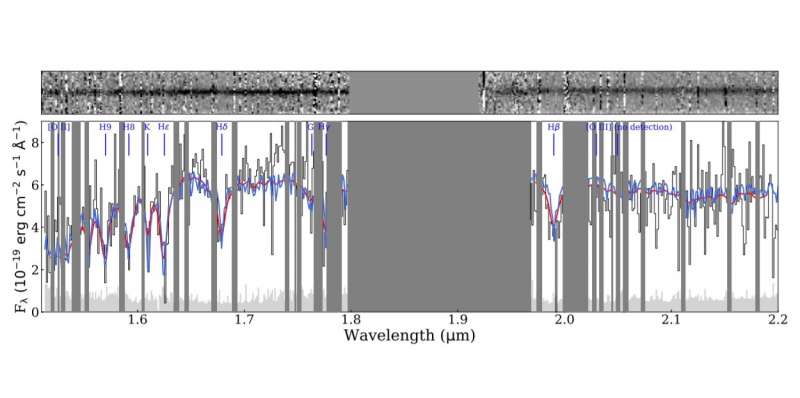Massive quiescent galaxy found in a distant protocluster

Using the Keck I telescope, Japanese astronomers have identified a massive quiescent galaxy in a distant galaxy protocluster known as SSA22. The galaxy, designated ADF22-QG1, turns out to be the most distant quiescent galaxy in a protocluster to date. The finding is reported in a paper published June 21 on the arXiv pre-print repository.
Massive galaxies that stopped forming stars (known as massive quiescent galaxies) are plausible progenitors of giant elliptical galaxies. Given that these objects formed stars earlier and assembled their stellar masses more quickly, they could be key to improving our understanding of the process of galaxy evolution.
In order to get more insights into the nature of massive quiescent galaxies it is also important to investigate their environments. However, these objects are mostly found in general fields or their environments are poorly explored and so far spectral characteristics of such galaxies have not yet been performed in galaxy protoclusters.
Hence, a group of astronomers led by Mariko Kubo of Ehime University inspected SSA22, a galaxy protocluster at a redshift of 3.09. Previous studies of SSA22 have shown that this large structure is an excellent place to observe the transition of starburst galaxies into quiescent ones. Kubo’s team has employed the multi-object spectrometer for infrared exploration (MOSFIRE) at the Keck I telescope to search for massive quiescent galaxies in this protocluster.
“In this paper, we report the confirmation of a massive quiescent galaxy at the ADF22 field of the SSA22 protocluster by detecting the absorption features spectroscopically with multi-object spectrometer for infrared exploration (MOSFIRE),” the researchers wrote in the study.
The observations confirmed the presence of ADF22-QG1 in the protocluster SSA22 by detecting the Balmer and Ca II absorption features with MOSFIRE. The data show that the object is a massive galaxy with suppressed star formation.
The astronomers estimate that ADF22-QG1 experienced a sudden quenching of star formation about 600 million years ago. Its current star formation rate was calculated to be less than 0.3 solar masses per year.
According to the paper, ADF22-QG1 has an effective radius of about 3,270 light years and is as a member of an extremely dense group of massive galaxies and submillimeter galaxies (SMGs) predicted as a progenitor of brightest cluster galaxies (BCGs) in cosmological numerical simulations.
“Here, we confirm a compact massive quiescent galaxy as a secure progenitor of a giant elliptical or brightest cluster galaxy (BCG) in a cluster of galaxies today,” the astronomers wrote.
The study also confirmed three plausible emitters of ionized oxygen [O III] around ADF22-QG1. The authors of the paper noted that two of them are possible evidence of the interaction between the quiescent galaxy and its nearest massive galaxy.



 Creators of mankind
Creators of mankind Description of “Tall white aliens”
Description of “Tall white aliens” Where they came from?
Where they came from? About hostile civilizations
About hostile civilizations The war for the Earth
The war for the Earth “Tall white aliens” about eternal life
“Tall white aliens” about eternal life Video: “Nordic aliens”
Video: “Nordic aliens” Aliens
Aliens Alien encounters
Alien encounters The aliens base
The aliens base UFO
UFO Technology UFO
Technology UFO Underground civilization
Underground civilization Ancient alien artifacts
Ancient alien artifacts Military and UFO
Military and UFO Mysteries and hypotheses
Mysteries and hypotheses Scientific facts
Scientific facts


















